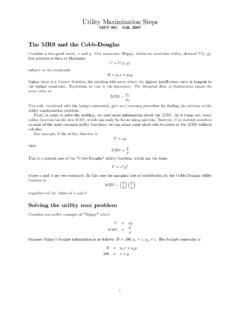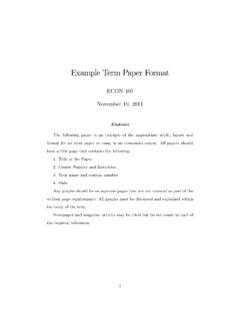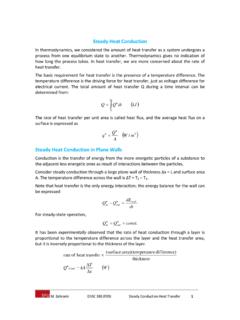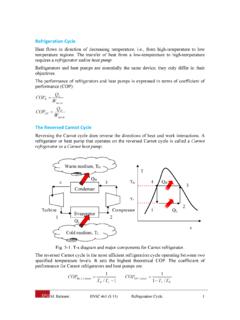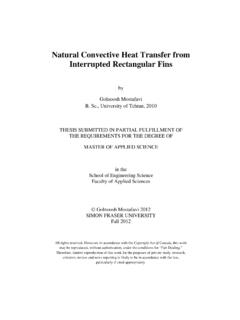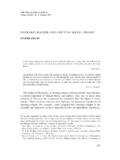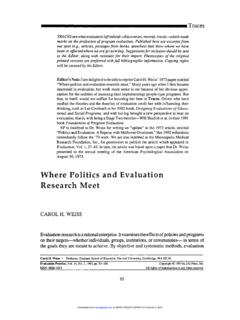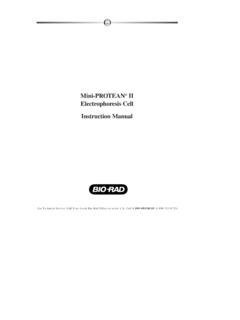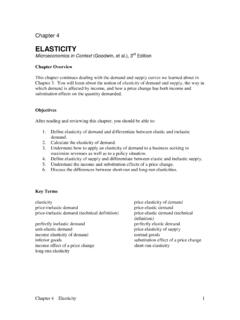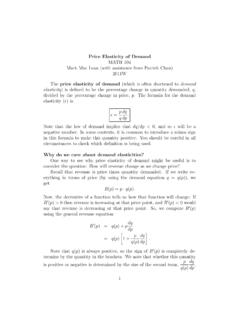Transcription of Chapter 1 Neoclassical growth theory - Simon Fraser …
1 Chapter 1 Neoclassical growth The Solow growth modelThe general questions of growth : What are the determinants of long-run economic growth ? How can we explain the vast differences in both output levels andgrowth rates across countries/time?Solow s specific question: What do simple Neoclassical assumptions implyabout growth ? His key assumptions include: Constant returns to scale. Perfect competition. Complete information. No The basic modelTime and demographyTime is discrete. Our notation is going to use subscripts;Xtis the value ofvariableXat 1. Neoclassical growth THEORYAn aside: in Romer, most of the models are in continuous time, while I willgenerally use discrete time. Notation differs between continuous time anddiscrete time models, butalmostany macro model can be written in either- the difference is usually a matter of taste and convenience.
2 You will beresponsible for learning to use both economy has one consumer with infinite lifetime, and one consumer supplies laborLtto the market, at market wagewt. Theconsumer also owns all of the capitalKtand rents to the market at rentalratert. The consumer also owns the firm and receives its total profit is thus:Yt=rtKt+wtLt+ t( )Labor supply grows at exogenous rategL, :Lt+1= (1 +gL)Lt( )Even though we have only one consumer, the fact that his labor supply isgrowing over time captures the idea of an expanding is accumulated by the consumer and depreciates at rate .Kt+1= (1 )Kt+It( )whereItis gross investment. Notice that the price of capital is one. We canalways set the price of one good in the economy to be one. Such a good iscalled the numeraire we were doing research right now, we would write down a general equilib-rium model, with a utility function for the consumer which determines howlabor supply responds to wages, and how investment responds to the returnon capital.
3 Soon we will do just that. But for now, we ll take the sameshortcut that Solow took. We ll write down the consumer s decision The consumer saves some exogenous fractionsof The consumer supplies all of his labor and capital, regardless of prices(inelastically). THE SOLOW growth MODEL3so we can rewrite equation ( ) as:Kt+1= (1 )Kt+sYt( )FirmThe firm can take capital and labor and convert it into output (consump-tion and new capital) which is then sold back to the consumer. The firm stechnology is described by the production functionYt=F(Kt, AtLt).Atis the level of technology at timet. It grows at exogenous rategA:At+1= (1 +gA)At( )In this formulation, technological progress is labor augmenting , meaningthat it increases the effective amount of labor. We could also in principle have capital augmenting technical progress or neutral technological progressYt=AtF(Kt, Lt).
4 It will turn out that a lot of the things we will do are alot easier if we assume labor augmenting technical will also assume thatFis a Neoclassical production ( Neoclassical production function)The Neoclassical pro-duction functionF(K, L)has the following homogeneous of degree 1. Formally, for anyc 0,F(cK, cL) =cF(K, L). In other words, production exhibits constant returns to Both factors are necessary, ,F(0, L) =F(K,0) = 0, for anyK, Both factors contribute to output: F(K, L) K>0( ) F(K, L) L>0( )4. The firm has decreasing returns in each product, orFis concave inboth arguments: 2F(K, L) K2<0( ) 2F(K, L) L2<0( )4 Chapter 1. Neoclassical growth THEORY5. The Inada conditions hold:limK 0 F(K, L) K= ( )limK F(K, L) K= 0( )The firm s profits are t=F(Kt, AtLt) rtKt wtLt( )Because firm profits go to the consumer, the consumer s income is equal tothe firm s total output:Yt=F(Kt, AtLt)( )MarketsAll goods are traded on a competitive market.
5 Whenever we write downa macroeconomic model, we usually have to define an equilibrium in themodel equilibrium for this model is a sequence of factor prices{wt},{rt}andallocations{Kt, Lt}such that1. The capital stockKt, labor supplyLt, and technology levelAtaredetermined by equations ( ), ( ), and ( ), and initial conditionsK0,L0, andA0, Taking prices as given, the firm purchases capitalKtand laborLttomaximize its profits ( ).3. Markets clear, that is, the capital and labor demand of the firm atpriceswtandrtare equal to the general an equilibrium has the same elements. The equilibrium itself is avector or sequence of prices and allocations. We impose two types of condi-tions on them - first that the various agents in the model choose allocationsto maximize utility, taking prices as given. Then we impose the condition onprices that markets clear.
6 Usually in the applications we will be looking at,the market-clearing condtion pins everything THE SOLOW growth So what do we think?This model would be unpublishable today, but managed to win Solow aNobel Prize. The main methodological failing of the model from a currentperspective is that the actions of the consumer are simply assumed. In amodern macro model you are expected to write down a utility function andset of budget constraints for the representative consumer, and derive theconsumer s optimal actions. In a week or two we will do just that this model will be useless as a means of analyzing Business cycles (we need shocks to AD or AS) Monetary policy (we need money) Unemployment (we need either a labor/leisure tradeoff, or some reasonwhy labor markets don t clear) Welfare effects of policy (we need a utility function and policy instru-ments)However, it will prove very useful for analyzing the relative contribution ofcapital and technical progress to economic Wages and interest ratesBecause the factor markets are competitive, factors are rented by firms atmarginal revenue product, and firm profits are zero.
7 The wage, therefore iswt= F(Kt, AtLt) Lt( )and the rental rate of capital isrt= F(Kt, AtLt) Kt( )Suppose that you invested in one unit of capital today. Tomorrow you wouldgetrt+1in rents on that capital, and (1 ) units of undepreciated net return on capital (also called the interest rate) isrt+1 .6 Chapter 1. Neoclassical growth THEORYF actor shares and output elasticitySuppose we could estimate Labor s share of output : L=Total wages paidGDP( )Generally, estimates of Lrun around Capital s share, Lis thus we derive the implied value of labor s share from the model? Yes: L=wtLtYt( )= Yt LtLtYtNotice that this is the output elasticity of the same reasoning, capital s share is the output elasticity of capital. Inother words, Solow s model and the data together imply that a one percentgrowth in the labor force leads to a percent increase in output.
8 A onepercent increase in the capital stock increases output by growth accountingHow much of a country s growth can be explained by: Labor force growth Capital accumulation Technical progressSolow s model allows us to decompose growth into these three we make a first-order Taylor series approximation:Yt+1 Yt= Y K K=Kt (Kt+1 Kt)( )+ Y L L=Lt (Lt+1 Lt) THE SOLOW growth MODEL7+ Y A A=At (At+1 At)+ approximation errorDivide byYton both sides. YtYt= Y K KtYt+ Y L LtYt+ Y A AtYt( )The equation above decomposes GDP growth into portions that can be at-tributed to growth in the capital stock, the labor force, and the technologylevel. Now, Y K KtYt= Y K KtKtKtYt( )= K KtKt= KgKWe can do this for labor as well: Y L LtYt= Y L LtLtLtYt( )= L LtLt= LgL= (1 K)gLand for productivity: Y A AtYt= Y A AtAtAtYt( )= Y AAtYt AtAt= AgASubstituting back in:gy= KgK+ (1 K)gL+ AgA( )or Aga=gy KgK (1 K)gL( )8 Chapter 1.
9 Neoclassical growth THEORYSo if we have observations on the growth rate of output, the labor force, andthe capital stock, we can have an estimate on the growth rate of total factorproductivity. Equation ( ) defines the Solow residual. Sometimes people use the term Solow residual to refer to what I ve calledtotal factor productivity, so they call equation ( ) the growth rate of theSolow what is the Solow residual? Conservative version - the part of growth which is not explained bycapital accumulation and labor force expansion. A measure of ourignorance, as Solow himself put it. Ambitious version - the part of growth which is explained by what are the critical assumptions here? Perfect competition and constantreturns to scale. Without those factor shares and output elasticities are notidentical. Note that we have yet to use the savings rate in any of this.
10 As aresult, the growth accounting procedure used above will still work in a morecomplex model which preserves these two we have estimates of capital s share of output, as well as the growthrates of output, capital, and labor, we can estimate the Solow residual formany industrialized countries. Here s a table that describes Solow residualsfor some countries from 1947-1973:CountryCapital s GDP from from TFP % of growthShare growth capital labor growth from THE SOLOW growth MODEL9 These results, and Solow s results at the time, showed that growth in TFPaccounted for a large fraction of total output growth . The conclusion drawnfrom these results is that technological advance is very important in explain-ing s take a look at some more recent figures. These are from a famous paperby Alwyn Young (1994 QJE) called The tyranny of numbers: confrontingthe statistical realities of the East Asian growth experience.
